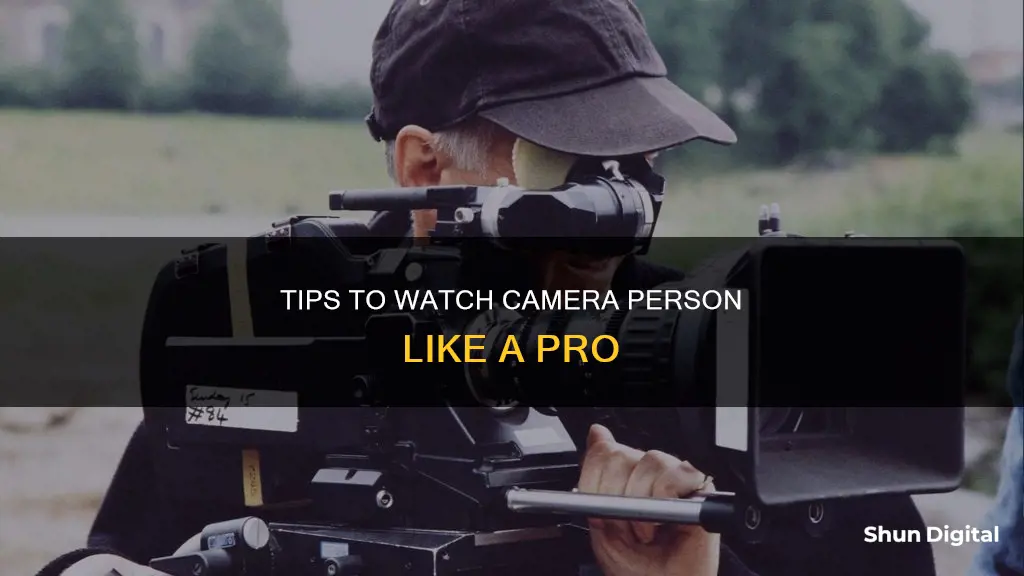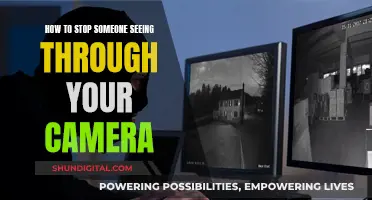
Cameraperson is a documentary film by Kirsten Johnson, weaving together footage from her 25-year career as a cinematographer. The film includes scenes from a boxing match in Brooklyn, life in postwar Bosnia and Herzegovina, and an intimate family moment. Through these episodic juxtapositions, Johnson explores the complex relationship between image-makers, their subjects, and the camera's role in mediating reality. Cameraperson is currently available on streaming platforms such as Max, Amazon Channel, and Criterion Channel, offering a unique glimpse into the world through Johnson's lens.
| Characteristics | Values |
|---|---|
| Name of the movie | Cameraperson |
| Director | Kirsten Johnson |
| Year of release | 2016 |
| Genre | Documentary, autobiography, ethical inquiry |
| Streaming services | Max, Max Amazon Channel, Criterion Channel |
| Available for purchase/rent | Amazon Video, Apple TV |
What You'll Learn

Kirsten Johnson's career as a cinematographer
Kirsten Johnson is a New York-based documentary filmmaker and cinematographer. She is one of only 5% of women members of the American Society of Cinematographers. Johnson has worked on over 40 feature-length documentaries, including several well-known films such as Citizenfour and The Oath.
Johnson's cinematography career began after graduating from Brown University in 1987 with a BA in Fine Arts and Literature. She then entered the filmmaking world in West Africa, where she gained experience in both fiction and non-fiction genres. She went on to study film in Paris, and later became a principal cameraperson for a range of documentaries, travelling to numerous countries including Bosnia, Darfur, Kabul and Texas.
Johnson has received numerous awards and nominations for her work. Her film Cameraperson (2016), which she directed and photographed, premiered at the Sundance Film Festival and was named one of the best films of 2016 by The New York Times and The Washington Post. It was also awarded three Cinema Eye Honors, including 'Outstanding Nonfiction Feature'. Johnson's camerawork has also appeared in Academy Award-winning films such as Citizenfour and Fahrenheit 9/11, as well as the Academy Award-nominated film The Invisible War.
In addition to her cinematography work, Johnson has directed six films, including Cameraperson and Dick Johnson Is Dead, which premiered at the 2020 Sundance Film Festival and received a special award for innovation in nonfiction storytelling. Johnson is currently a faculty member at NYU, where she teaches documentary filmmaking and cinematography.
Target's Surveillance: Cameras Watching You?
You may want to see also

The relationship between image-makers and their subjects
Image-makers, such as photographers and filmmakers, have a unique power to capture and present moments, people, and places through their lens. They make choices about what to include and exclude, what to focus on, and how to frame a scene. These choices are influenced by their personal interests, experiences, and biases. A photographer's job is to be "actively engaged in the condition of looking for something." They must look beyond the surface and consider light, shadow, and composition to create powerful images that convey a message or tell a story.
The subjects of these images, whether they are people, landscapes, or objects, often have their own stories and meanings that the image-maker must respect and accurately portray. It is important to consider the context, the narrative, and the impact on the subject. For example, a photograph of a person can convey their emotions, but it is also important to consider the circumstances that led to that moment and the impact that sharing this image may have on the subject's life.
Additionally, the interpretation of an image is not solely determined by the image-maker. The viewer brings their own perspective and understanding, influenced by their personal experiences and cultural background. The meaning of an image is often subjective and can vary greatly among viewers. This subjectivity highlights the importance of context and captions, which can provide crucial information and guide the interpretation of the image.
Image-makers, therefore, have a responsibility to their subjects and viewers. They must consider the ethical implications of their work, obtain consent, and respect the privacy and dignity of their subjects. At the same time, they must also be mindful of their role in shaping public opinion and influencing social change, as evidenced by the powerful impact of photojournalism on issues such as war and social justice.
In conclusion, the relationship between image-makers and their subjects is a dynamic and collaborative process that involves a continuous dialogue between the artist, the subject, and the viewer. It requires empathy, respect, and a commitment to accurately and ethically portraying the stories and moments that are captured through the lens.
Viewing Your Camera Feed on Echo Show: A Guide
You may want to see also

Objectivity and intervention of the camera
The concept of objectivity in relation to the camera and the person behind it is a complex and multifaceted topic that has been explored by various scholars and practitioners in the field of photography, journalism, and film.
One perspective on objectivity in photography defines it as the independence of the subject matter from the subject's perception. In other words, the object or scene being captured by the camera exists independently of how the photographer or viewer interprets it. This view suggests that photographic objectivity occurs when the object or subject matter in front of the camera produces the photograph, while photographic subjectivity occurs when the photographer's viewpoint or influence is evident in the image.
However, it is important to acknowledge that the photographer's presence and choices inherently shape the final image. The photographer decides on factors such as framing, angle, perspective, and exposure, which inevitably introduce a degree of subjectivity to the photograph. This subjectivity can be intentional, such as in the case of artistic or documentary photography, where the photographer aims to convey a particular message or perspective.
In the context of journalism and news photography, the notion of objectivity takes on a different dimension. News photography is often associated with the idea of "bearing witness" to events and is expected to provide credible and authentic visual evidence to support the accompanying text. The resemblance between the scene and its photographic representation is of utmost importance, as the collapse of this truthful nature could undermine the credibility of the entire news story.
Furthermore, the perspective or angle from which a photograph is taken can significantly influence how it is perceived. Research has shown that variations in camera perspective can affect how individuals assess the veracity or reliability of a situation. For example, in the context of criminal interrogations, studies have found that footage focusing solely on the suspect can lead viewers to perceive the confession as more voluntary and the suspect as more likely guilty, compared to footage that includes both the suspect and the interviewer.
The camera's intervention, or the act of framing and capturing a scene, inherently introduces a layer of interpretation and subjectivity. This is particularly evident in the documentary film "Cameraperson," directed by Kirsten Johnson. The film is a compilation of footage she shot, reframed in a way that illuminates moments and situations that personally affected her. Through this curation and editing process, Johnson transforms the scenes, presenting a personal journey and interpretation of reality while still drawing on the expectation of objectivity associated with documentary photography.
In conclusion, while the camera can capture and present a version of reality, it is impossible to completely separate it from the intervention and subjectivity of the person behind the lens. The photographer's choices, intentional or not, shape how the audience perceives the final image. Recognizing and critically engaging with this dynamic between objectivity and intervention is crucial for a more nuanced understanding of visual media.
Finding the Best Spots to Mount 15 Cameras
You may want to see also

Unfiltered reality vs crafted narrative
The documentary film "Cameraperson" by Kirsten Johnson is a visually radical memoir that draws on the director's remarkable footage, reframed in ways that illuminate moments and situations that have personally affected her. It is a meditation on the relationship between truth and the camera frame, as Johnson transforms scenes that have been presented on Festival screens as one kind of truth into another kind of story—one about personal journey, craft, and direct human connection.
This film brings up the question of unfiltered reality vs crafted narrative. Documentary films are generally rooted in reality, capturing real and true events. They are defined by their lack of a pre-written script, instead of finding the story in post-production through editing. In contrast, narrative films are often fictional and tell a preconceived story created by a screenwriter, director, or producer. They are shot with specific images in mind, and a script is written before shooting begins.
However, the line between these two genres is not always clear, and some filmmakers, like Martin Scorsese, attempt to blur it to achieve something more authentic. "Cameraperson" is an example of a film that challenges the boundaries of traditional documentary filmmaking. By reframing existing footage, Johnson creates a new narrative that explores her personal journey and connection to the scenes captured by the camera.
The act of filming itself can also be seen as a form of narrative crafting. The camera dictates where we look and when, providing all the information we need to construct a narrative. This is true whether the camera is restricted to the experiences of a single character or allowed to follow multiple characters. In both cases, it serves as the primary narrator of the story, shaping our perspective and understanding of the events unfolding on screen.
Ultimately, whether a film leans towards unfiltered reality or crafted narrative, it is the collaboration between various creative roles that brings it to life. From the screenwriter to the cinematographer, production designer, and editor, each contributes their unique perspective and skills to shape the final product.
The Privacy Paradox: Cameras in Suicide Watch Cells
You may want to see also

Ethical inquiry in documentary film-making
Ethical Inquiry in Documentary Filmmaking
The documentary film "Cameraperson," directed by Kirsten Johnson, raises important questions about the ethical dimensions of documentary filmmaking. Johnson's film is a tapestry of footage captured over her 25-year career, exploring the relationships between image-makers and their subjects, the tension between objectivity and intervention, and the complex interplay between unfiltered reality and crafted narrative. As documentary filmmakers navigate the murky waters of ethics, they grapple with their responsibilities to their subjects, viewers, and artistic vision. This discussion will delve into these ethical inquiries, offering insights into the complex world of documentary filmmaking.
The Relationship Between Image-Makers and Their Subjects
One of the central ethical inquiries in documentary filmmaking revolves around the power dynamics between the filmmaker and the subject. Filmmakers have the challenging task of maintaining a humane working relationship with their subjects while also telling a compelling and honest story. This dynamic is further complicated by the vulnerability of many documentary subjects, who often share intimate and traumatic experiences on camera. As Johnson notes, there is a sympathetic relationship in which the filmmaker has more social and economic power than the subject, necessitating a careful approach to protect the subject from potential harm. This power differential may lead filmmakers to make unilateral decisions, such as omitting sensitive material, to safeguard their subjects.
Tension Between Objectivity and Intervention
Documentary filmmakers constantly grapple with the tension between maintaining objectivity and intervening in the lives of their subjects. While striving for objectivity and unbiased portrayal, filmmakers may also feel a sense of responsibility to intervene, especially when their subjects are vulnerable or at risk. This tension is heightened when filmmakers are immersed in difficult social situations or witness unethical behaviour. As Johnson's film illustrates, the decision to intervene or remain objective is not always clear-cut and often involves complex ethical dilemmas.
Unfiltered Reality vs. Crafted Narrative
The interplay between unfiltered reality and crafted narrative is another ethical conundrum in documentary filmmaking. While filmmakers aim to portray reality honestly, they also recognise the need to manipulate and shape their footage to create a compelling narrative. This manipulation may involve rearranging facts, sequences, and meanings of images to effectively convey the overall truthfulness of the story. However, this blurs the lines between factual accuracy and creative storytelling, raising questions about the ethical boundaries of such manipulations.
Ethical inquiry in documentary filmmaking is a complex and ongoing dialogue. Filmmakers must navigate a range of responsibilities, including protecting vulnerable subjects, honouring the trust of viewers, and maintaining their artistic integrity. While there are no clear-cut solutions, filmmakers like Johnson contribute to this discussion by reflecting on their own practices and the impact of their work on subjects and audiences. As the documentary field continues to evolve, a more sustained and public conversation about ethics is necessary to develop shared standards and practices that uphold the integrity of the craft.
Are Street Signs Watched by Cameras?
You may want to see also
Frequently asked questions
You can watch Cameraperson on Max, Max Amazon Channel, or Criterion Channel. You can also buy or rent it on Amazon Video or Apple TV.
Cameraperson is a documentary, autobiography, and ethical inquiry by Kirsten Johnson, weaving together footage from her 25-year career as a cinematographer. It explores the relationship between image-makers and their subjects, the role of the camera, and the interaction of reality with narrative.
Cameraperson includes a boxing match in Brooklyn, life in postwar Bosnia and Herzegovina, the daily routine of a Nigerian midwife, and an intimate family moment.
Cameraperson won Best Documentary Feature at the San Francisco International Film Festival. It was also nominated for Best Documentary at the Film Independent Spirit Awards and the Gamechanger Award at SXSW.
Cameraperson is 1 hour and 42 minutes long.







